Embedded Sensors for Structural Health Monitoring: Methodologies and Applications Review
Abstract
1. Introduction
2. Fundaments and Techniques of SHM
3. Sensor Technology
4. Embedded Sensors and Its Applications
4.1. Fibre Optic Sensors
4.1.1. Applications for Composite Components
4.1.2. Applications for Metal Components
4.2. Piezoelectric Sensors
4.2.1. Applications for Composite Components
4.2.2. Applications for Metal Components
4.3. Other Embedded Sensors
4.3.1. Applications for Composite Components
4.3.2. Applications for Metal Components
5. Methodology for Sensor Integration
5.1. For Composite Components
5.2. For Metal Components
6. Discussion and Challenges in Embedded Sensors
7. Conclusions
Author Contributions
Funding
Institutional Review Board Statement
Informed Consent Statement
Acknowledgments
Conflicts of Interest
References
- Spencer, B.F.; Ruiz-Sandoval, M.E.; Kurata, N. Smart Sensing Technology: Opportunities and Challenges. Struct. Control Health Monit. 2004, 11, 349–368. [Google Scholar] [CrossRef]
- Andreades, C.; Malfense Fierro, G.P.; Meo, M. A Nonlinear Ultrasonic SHM Method for Impact Damage Localisation in Composite Panels Using a Sparse Array of Piezoelectric PZT Transducers. Ultrasonics 2020, 108, 106181. [Google Scholar] [CrossRef]
- Duarte, V.R.; Rodrigues, T.A.; MacHado, M.A.; Pragana, J.P.M.; Pombinha, P.; Coutinho, L.; Silva, C.M.A.; Miranda, R.M.; Goodwin, C.; Huber, D.E.; et al. Benchmarking of Nondestructive Testing for Additive Manufacturing. 3D Print. Addit. Manuf. 2021, 8, 263–270. [Google Scholar] [CrossRef]
- Machado, M.A.; Silva, M.I.; Martins, A.P.; Carvalho, M.S.; Santos, T.G. Double Active Transient Thermography. NDT E Int. 2021, 125, 102566. [Google Scholar] [CrossRef]
- Santos, T.G.; Oliveira, J.P.; Machado, M.A.; Inácio, P.L.; Duarte, V.R.; Rodrigues, T.A.; Santos, R.A.; Simão, C.; Carvalho, M.; Martins, A.; et al. Reliability and NDT Methods. In Additive Manufacturing Hybrid Processes for Composites Systems; Springer: Cham, Switzerland, 2020; pp. 265–295. [Google Scholar] [CrossRef]
- Machado, M.A.; Rosado, L.; Pedrosa, N.; Miranda, R.M.; Piedade, M.S.T. Customized Eddy Current Probes for Pipe Inspection. Stud. Appl. Electromagn. Mech. 2017, 42, 283. [Google Scholar] [CrossRef]
- Machado, M.A.; Rosado, L.S.; Mendes, N.M.; Miranda, R.M.; Santos, T.G. Multisensor Inspection of Laser-Brazed Joints in the Automotive Industry. Sensors 2021, 21, 7335. [Google Scholar] [CrossRef]
- Costa, F.B.; Machado, M.A.; Bonfait, G.J.; Vieira, P.; Santos, T.G. Continuous Wave Terahertz Imaging for NDT: Fundamentals and Experimental Validation. Measurement 2021, 172, 108904. [Google Scholar] [CrossRef]
- Balageas, D.; Fritzen, C.-P.; Güemes, A. Structural Health Monitoring; John Wiley & Sons: Hoboken, NJ, USA, 2010; Volume 90, ISBN 1-905209-01-0. [Google Scholar]
- Fu, Y.; Peng, C.; Gomez, F.; Narazaki, Y.; Spencer, B.F. Sensor Fault Management Techniques for Wireless Smart Sensor Networks in Structural Health Monitoring. Struct. Control Health Monit. 2019, 26, e2362. [Google Scholar] [CrossRef]
- Ou, J.; Li, H. Structural Health Monitoring in Mainland China: Review and Future Trends. Struct. Healht Monit. 2010, 9, 219–231. [Google Scholar] [CrossRef]
- Sony, S.; Laventure, S.; Sadhu, A. A Literature Review of Next-Generation Smart Sensing Technology in Structural Health Monitoring. Struct. Control Health Monit. 2019, 26, e2321. [Google Scholar] [CrossRef]
- Güemes, A.; Fernandez-Lopez, A.; Pozo, A.R.; Sierra-Pérez, J. Structural Health Monitoring for Advanced Composite Structures: A Review. J. Compos. Sci. 2020, 4, 13. [Google Scholar] [CrossRef]
- Brownjohn, J.M. Structural Health Monitoring of Civil Infrastructure. Philos. Trans. R. Soc. A Math. Phys. Eng. Sci. 2007, 365, 589–622. [Google Scholar] [CrossRef]
- Farrar, C.R.; Worden, K. An Introduction to Structural Health Monitoring. Philos. Trans. R. Soc. A Math. Phys. Eng. Sci. 2007, 365, 303–315. [Google Scholar] [CrossRef]
- Montalvao, D. A Review of Vibration-Based Structural Health Monitoring with Special Emphasis on Composite Materials. Shock Vib. Dig. 2006, 38, 295–324. [Google Scholar] [CrossRef]
- Lopez-Higuera, J.M.; Rodriguez Cobo, L.; Quintela Incera, A.; Cobo, A. Fiber Optic Sensors in Structural Health Monitoring. J. Light. Technol. 2011, 29, 587–608. [Google Scholar] [CrossRef]
- Qing, X.; Li, W.; Wang, Y.; Sun, H. Piezoelectric Transducer-Based Structural Health Monitoring for Aircraft Applications. Sensors 2019, 19, 545. [Google Scholar] [CrossRef]
- Palma, P.; Steiger, R. Structural Health Monitoring of Timber Structures – Review of Available Methods and Case Studies. Constr. Build. Mater. 2020, 248, 118528. [Google Scholar] [CrossRef]
- Machado, M.A.; Antin, K.-N.; Rosado, L.S.; Vilaça, P.; Santos, T.G. High-Speed Inspection of Delamination Defects in Unidirectional CFRP by Non-Contact Eddy Current Testing. Compos. Part B Eng. 2021, 224, 109167. [Google Scholar] [CrossRef]
- Antin, K.-N.; Machado, M.A.; Santos, T.G.; Vilaça, P. Evaluation of Different Non-Destructive Testing Methods to Detect Imperfections in Unidirectional Carbon Fiber Composite Ropes. J. Nondestruct. Eval. 2019, 38, 23. [Google Scholar] [CrossRef]
- Machado, M.A.; Antin, K.-N.; Rosado, L.S.; Vilaça, P.; Santos, T.G. Contactless High-Speed Eddy Current Inspection of Unidirectional Carbon Fiber Reinforced Polymer. Compos. Part B Eng. 2019, 168, 226–235. [Google Scholar] [CrossRef]
- Brownjohn, J.M.W.; De Stefano, A.; Xu, Y.-L.; Wenzel, H.; Aktan, A.E. Vibration-Based Monitoring of Civil Infrastructure: Challenges and Successes. J. Civ. Struct. Health Monit. 2011, 1, 79–95. [Google Scholar] [CrossRef]
- Humar, J.; Bagchi, A.; Xu, H. Performance of Vibration-Based Techniques for the Identification of Structural Damage. Struct. Health Monit. 2006, 5, 215–241. [Google Scholar] [CrossRef]
- Deraemaeker, A.; Reynders, E.; De Roeck, G.; Kullaa, J. Vibration-Based Structural Health Monitoring Using Output-Only Measurements under Changing Environment. Mech. Syst. Signal Process. 2008, 22, 34–56. [Google Scholar] [CrossRef]
- Sandykbayeva, D.; Kappassov, Z.; Orazbayev, B. VibroTouch: Active Tactile Sensor for Contact Detection and Force Sensing via Vibrations. Sensors 2022, 22, 6456. [Google Scholar] [CrossRef] [PubMed]
- Luyckx, G.; Voet, E.; Lammens, N.; Degrieck, J. Strain Measurements of Composite Laminates with Embedded Fibre Bragg Gratings: Criticism and Opportunities for Research. Sensors 2010, 11, 384–408. [Google Scholar] [CrossRef]
- Campanella, C.; Cuccovillo, A.; Campanella, C.; Yurt, A.; Passaro, V. Fibre Bragg Grating Based Strain Sensors: Review of Technology and Applications. Sensors 2018, 18, 3115. [Google Scholar] [CrossRef]
- Fidanboylu, K.A.; Efendioglu, H.S. Fiber Optic Sensors and Their Applications. In Proceedings of the 5th International Advanced Technologies Symposium (IATS’09), Karabuk, Turkey, 13–15 May 2009; Volume 6, pp. 2–3. [Google Scholar]
- Li, H.-N.N.; Li, D.S.; Song, G.B. Recent Applications of Fiber Optic Sensors to Health Monitoring in Civil Engineering. Eng. Struct. 2004, 26, 1647–1657. [Google Scholar] [CrossRef]
- Du, C.; Dutta, S.; Kurup, P.; Yu, T.; Wang, X. A Review of Railway Infrastructure Monitoring Using Fiber Optic Sensors. Sens. Actuators A Phys. 2020, 303, 111728. [Google Scholar] [CrossRef]
- Bao, Y.; Huang, Y.; Hoehler, M.; Chen, G. Review of Fiber Optic Sensors for Structural Fire Engineering. Sensors 2019, 19, 877. [Google Scholar] [CrossRef]
- Güemes, A.; Fernández-López, A.; Díaz-Maroto, P.; Lozano, A.; Sierra-Perez, J. Structural Health Monitoring in Composite Structures by Fiber-Optic Sensors. Sensors 2018, 18, 1094. [Google Scholar] [CrossRef] [PubMed]
- Park, G.; Farrar, C.R.; di Scalea, F.L.; Coccia, S. Performance Assessment and Validation of Piezoelectric Active-Sensors in Structural Health Monitoring. Smart Mater. Struct. 2006, 15, 1673–1683. [Google Scholar] [CrossRef]
- Na, W.; Baek, J. A Review of the Piezoelectric Electromechanical Impedance Based Structural Health Monitoring Technique for Engineering Structures. Sensors 2018, 18, 1307. [Google Scholar] [CrossRef]
- Ha, S.K.; Keilers, C.; Chang, F.-K. Finite Element Analysis of Composite Structures Containing Distributed Piezoceramic Sensors and Actuators. AIAA J. 1992, 30, 772–780. [Google Scholar] [CrossRef]
- Giurgiutiu, V.; Zagrai, A.; Jing Bao, J. Piezoelectric Wafer Embedded Active Sensors for Aging Aircraft Structural Health Monitoring. Struct. Health Monit. 2002, 1, 41–61. [Google Scholar] [CrossRef]
- Dong, B.; Li, Z. Cement-Based Piezoelectric Ceramic Smart Composites. Compos. Sci. Technol. 2005, 65, 1363–1371. [Google Scholar] [CrossRef]
- Baptista, F.; Budoya, D.; Almeida, V.; Ulson, J. An Experimental Study on the Effect of Temperature on Piezoelectric Sensors for Impedance-Based Structural Health Monitoring. Sensors 2014, 14, 1208–1227. [Google Scholar] [CrossRef]
- Karhunen, K.; Seppänen, A.; Lehikoinen, A.; Monteiro, P.J.M.; Kaipio, J.P. Electrical Resistance Tomography Imaging of Concrete. Cem. Concr. Res. 2010, 40, 137–145. [Google Scholar] [CrossRef]
- Baltopoulos, A.; Polydorides, N.; Pambaguian, L.; Vavouliotis, A.; Kostopoulos, V. Damage Identification in Carbon Fiber Reinforced Polymer Plates Using Electrical Resistance Tomography Mapping. J. Compos. Mater. 2013, 47, 3285–3301. [Google Scholar] [CrossRef]
- Tallman, T.N.; Wang, K.W. Damage and Strain Identification in Multifunctional Materials via Electrical Impedance Tomography with Constrained Sine Wave Solutions. Struct. Health Monit. 2016, 15, 235–244. [Google Scholar] [CrossRef]
- Silva, D.D.S.; Sobrinho, J.M.B.; Souto, C.R.; Gomes, R.M. Application of Electromechanical Impedance Technique in the Monitoring of Sigma Phase Embrittlement in Duplex Stainless Steel. Mater. Sci. Eng. A 2020, 788, 139457. [Google Scholar] [CrossRef]
- Machado, M.A.; Rosado, L.S.; Santos, T.G. Shaping Eddy Currents for Non-Destructive Testing Using Additive Manufactured Magnetic Substrates. J. Nondestruct. Eval. 2022, 41, 50. [Google Scholar] [CrossRef]
- Machado, M.A.; Rosado, L.F.S.G.; Mendes, N.A.M.; Miranda, R.M.M.; dos Santos, T.J.G. New Directions for Inline Inspection of Automobile Laser Welds Using Non-Destructive Testing. Int. J. Adv. Manuf. Technol. 2022, 118, 1183–1195. [Google Scholar] [CrossRef]
- Wilson, J.S. Sensor Technology Handbook; Elsevier: Amsterdam, The Netherlands, 2004; ISBN 0-7506-7729-5. [Google Scholar]
- Saeedifar, M.; Mansvelder, J.; Mohammadi, R.; Zarouchas, D. Using Passive and Active Acoustic Methods for Impact Damage Assessment of Composite Structures. Compos. Struct. 2019, 226, 111252. [Google Scholar] [CrossRef]
- Liu, M.; Zeng, Z.; Xu, H.; Liao, Y.; Zhou, L.; Zhang, Z.; Su, Z. Applications of a Nanocomposite-Inspired in-Situ Broadband Ultrasonic Sensor to Acousto-Ultrasonics-Based Passive and Active Structural Health Monitoring. Ultrasonics 2017, 78, 166–174. [Google Scholar] [CrossRef]
- Chandarana, N.; Soutis, C.; Gresil, M. Passive and Active Monitoring for Defect Detection and Quantification in Composites. In Proceedings of the Health Monitoring of Structural and Biological Systems XII, Denver, CO, USA, 27 March 2018; Volume 10600, p. 71. [Google Scholar]
- Wang, Y.; Hu, S.; Xiong, T.; Huang, Y.; Qiu, L. Recent Progress in Aircraft Smart Skin for Structural Health Monitoring. Struct. Health Monit. 2022, 21, 2453–2480. [Google Scholar] [CrossRef]
- Janeliukstis, R.; Mironovs, D. Smart Composite Structures with Embedded Sensors for Load and Damage Monitoring – A Review. Mech. Compos. Mater. 2021, 57, 131–152. [Google Scholar] [CrossRef]
- Di Sante, R. Fibre Optic Sensors for Structural Health Monitoring of Aircraft Composite Structures: Recent Advances and Applications. Sensors 2015, 15, 18666–18713. [Google Scholar] [CrossRef]
- Rajan, G. Optical Fiber Sensors: Advanced Techniques and Applications; Taylor & Francis: Abingdon, UK, 2017. [Google Scholar]
- Jackson, D.A.; Jones, J.D.C. Fibre Optic Sensors. Opt. Acta Int. J. Opt. 1986, 33, 1469–1503. [Google Scholar] [CrossRef]
- Amanzadeh, M.; Aminossadati, S.M.; Kizil, M.S.; Rakić, A.D. Recent Developments in Fibre Optic Shape Sensing. Measurement 2018, 128, 119–137. [Google Scholar] [CrossRef]
- Su, Y.-D.; Preger, Y.; Burroughs, H.; Sun, C.; Ohodnicki, P. Fiber Optic Sensing Technologies for Battery Management Systems and Energy Storage Applications. Sensors 2021, 21, 1397. [Google Scholar] [CrossRef] [PubMed]
- Inaudi, D.; Glisic Smartec, B.S. Overview of Fibre Optic Sensing Applications to Structural Health Monitoring. In Proceedings of the Symposium on Deformation Measurement and Analysis, Lisbon, Portugal, 12–15 May 2008. [Google Scholar]
- Ou, R.; Luo, L.; Soga, K. Brillouin Scattering Spectrum-Based Crack Measurement Using Distributed Fiber Optic Sensing. Struct. Health Monit. 2021, 21, 1345–1366. [Google Scholar] [CrossRef]
- Li, C.; Tang, J.; Cheng, C.; Cai, L.; Yang, M. FBG Arrays for Quasi-Distributed Sensing: A Review. Photonic Sens. 2021, 11, 91–108. [Google Scholar] [CrossRef]
- Luo, P.; Zhang, D.; Wang, L.; Jiang, D. Structural Damage Detection Based on a Fiber Bragg Grating Sensing Array and a Back Propagation Neural Network: An Experimental Study. Struct. Health Monit. 2010, 9, 5–11. [Google Scholar] [CrossRef]
- Sieńko, R.; Zych, M.; Bednarski, Ł.; Howiacki, T. Strain and Crack Analysis within Concrete Members Using Distributed Fibre Optic Sensors. Struct. Health Monit. 2019, 18, 1510–1526. [Google Scholar] [CrossRef]
- Kuang, K.S.C.; Kenny, R.; Whelan, M.P.; Cantwell, W.J.; Chalker, P.R. Embedded Fibre Bragg Grating Sensors in Advanced Composite Materials. Compos. Sci. Technol. 2001, 61, 1379–1387. [Google Scholar] [CrossRef]
- Keulen, C.; Rocha, B.; Yildiz, M.; Suleman, A. Embedded Fiber Optic Sensors for Monitoring Processing, Quality and Structural Health of Resin Transfer Molded Components. J. Phys. Conf. Ser. 2011, 305, 012135. [Google Scholar] [CrossRef]
- Ramly, R.; Kuntjoro, W.; Rahman, M.K.A. Using Embedded Fiber Bragg Grating (FBG) Sensors in Smart Aircraft Structure Materials. Procedia Eng. 2012, 41, 600–606. [Google Scholar] [CrossRef]
- Bremer, K.; Weigand, F.; Zheng, Y.; Alwis, L.; Helbig, R.; Roth, B. Structural Health Monitoring Using Textile Reinforcement Structures with Integrated Optical Fiber Sensors. Sensors 2017, 17, 345. [Google Scholar] [CrossRef]
- Oromiehie, E.; Prusty, B.G.; Compston, P.; Rajan, G. Characterization of Process-Induced Defects in Automated Fiber Placement Manufacturing of Composites Using Fiber Bragg Grating Sensors. Struct. Health Monit. 2018, 17, 108–117. [Google Scholar] [CrossRef]
- Kousiatza, C.; Tzetzis, D.; Karalekas, D. In-Situ Characterization of 3D Printed Continuous Fiber Reinforced Composites: A Methodological Study Using Fiber Bragg Grating Sensors. Compos. Sci. Technol. 2019, 174, 134–141. [Google Scholar] [CrossRef]
- Mieloszyk, M.; Majewska, K.; Ostachowicz, W. Application of Embedded Fibre Bragg Grating Sensors for Structural Health Monitoring of Complex Composite Structures for Marine Applications. Mar. Struct. 2021, 76, 102903. [Google Scholar] [CrossRef]
- Maldonado-Hurtado, D.; Madrigal, J.; Penades, A.; Ruiz, R.; Crespo, A.I.; Sales, S. Pultruded FRP Beams with Embedded Fibre Bragg Grating Optical Sensors for Strain Measurement and Failure Detection. Sensors 2021, 21, 7019. [Google Scholar] [CrossRef] [PubMed]
- de Oliveira, R.; Ramos, C.A.; Marques, A.T. Health Monitoring of Composite Structures by Embedded FBG and Interferometric Fabry–Pérot Sensors. Comput. Struct. 2008, 86, 340–346. [Google Scholar] [CrossRef]
- Leng, J.; Asundi, A. Structural Health Monitoring of Smart Composite Materials by Using EFPI and FBG Sensors. Sensors Actuators A Phys. 2003, 103, 330–340. [Google Scholar] [CrossRef]
- Alwis, L.S.M.; Bremer, K.; Roth, B. Fiber Optic Sensors Embedded in Textile-Reinforced Concrete for Smart Structural Health Monitoring: A Review. Sensors 2021, 21, 4948. [Google Scholar] [CrossRef]
- Li, X.; Golnas, A.; Prinz, F.B. Shape Deposition Manufacturing of Smart Metallic Structures with Embedded Sensors. In Proceedings of the Smart Structures and Materials 2000: Sensory Phenomena and Measurement Instrumentation for Smart Structures and Materials, Newport Beach, CA, USA, 12 June 2000; Volume 3986, p. 160. [Google Scholar]
- Li, X.C.; Prinz, F.; Seim, J. Thermal Behavior of a Metal Embedded Fiber Bragg Grating Sensor. Smart Mater. Struct. 2001, 10, 575–579. [Google Scholar] [CrossRef]
- Li, X.; Prinz, F. Metal Embedded Fiber Bragg Grating Sensors in Layered Manufacturing. J. Manuf. Sci. Eng. 2003, 125, 577–585. [Google Scholar] [CrossRef]
- Li, X.; Prinz, F. Analytical and Experimental Study on Noncontact Sensing With Embedded Fiber-Optic Sensors in Rotating Metal Parts. J. Light. Technol. 2004, 22, 1720–1727. [Google Scholar] [CrossRef]
- Alemohammad, H.; Toyserkani, E. Metal Embedded Optical Fiber Sensors: Laser-Based Layered Manufacturing Procedures. J. Manuf. Sci. Eng. 2011, 133, 031015. [Google Scholar] [CrossRef]
- Schomer, J.J.; Dapino, M.J. High Temperature Characterization of Fiber Bragg Grating Sensors Embedded Into Metallic Structures Through Ultrasonic Additive Manufacturing. In Proceedings of the Volume 2: Modeling, Simulation and Control of Adaptive Systems; Integrated System Design and Implementation; Structural Health Monitoring, Snowbird, UT, USA, 18 September 2017; American Society of Mechanical Engineers: New York, NY, USA, 2017; Volume 58264, p. V002T05A003. [Google Scholar]
- Grandal, T.; Zornoza, A.; Fraga, S.; Castro, G.; Sun, T.; Grattan, K.T.V. Laser Cladding-Based Metallic Embedding Technique for Fiber Optic Sensors. J. Light. Technol. 2018, 36, 1018–1025. [Google Scholar] [CrossRef]
- Jinachandran, S.; Li, H.; Xi, J.; Prusty, B.G.; Semenova, Y.; Farrell, G.; Rajan, G. Fabrication and Characterization of a Magnetized Metal-Encapsulated FBG Sensor for Structural Health Monitoring. IEEE Sens. J. 2018, 18, 8739–8746. [Google Scholar] [CrossRef]
- Chilelli, S.K.; Schomer, J.J.; Dapino, M.J. Detection of Crack Initiation and Growth Using Fiber Bragg Grating Sensors Embedded into Metal Structures through Ultrasonic Additive Manufacturing. Sensors 2019, 19, 4917. [Google Scholar] [CrossRef] [PubMed]
- Hehr, A.; Norfolk, M.; Kominsky, D.; Boulanger, A.; Davis, M.; Boulware, P. Smart Build-Plate for Metal Additive Manufacturing Processes. Sensors 2020, 20, 360. [Google Scholar] [CrossRef]
- Gallego-Juarez, J.A. Piezoelectric Ceramics and Ultrasonic Transducers. J. Phys. E 1989, 22, 804–816. [Google Scholar] [CrossRef]
- Cady, W.G. Piezoelectricity: Volume Two: An Introduction to the Theory and Applications of Electromechanical Phenomena in Crystals; Courier Dover Publications: Mineola, NY, USA, 2018. [Google Scholar]
- Chong, K.P.; Carino, N.J.; Washer, G. Health Monitoring of Civil Infrastructures. Smart Mater. Struct. 2003, 12, 483–493. [Google Scholar] [CrossRef]
- Tressler, J.F.; Alkoy, S.; Newnham, R.E. Piezoelectric Sensors and Sensor Materials. J. Electroceram. 1998, 2, 257–272. [Google Scholar] [CrossRef]
- Horchidan, N.; Ciomaga, C.E.; Frunza, R.C.; Capiani, C.; Galassi, C.; Mitoseriu, L. A Comparative Study of Hard/Soft PZT-Based Ceramic Composites. Ceram. Int. 2016, 42, 9125–9132. [Google Scholar] [CrossRef]
- Wu, F.; Chang, F.-K. Debond Detection Using Embedded Piezoelectric Elements in Reinforced Concrete Structures—Part I: Experiment. Struct. Health Monit. 2006, 5, 5–15. [Google Scholar] [CrossRef]
- Konka, H.P.; Wahab, M.A.; Lian, K. The Effects of Embedded Piezoelectric Fiber Composite Sensors on the Structural Integrity of Glass-Fiber–Epoxy Composite Laminate. Smart Mater. Struct. 2012, 21, 015016. [Google Scholar] [CrossRef]
- Wu, C.; Xiang, H.; Jiang, S.; Ma, S. Stress Monitoring of Concrete via Uniaxial Piezoelectric Sensor. Sensors 2022, 22, 4041. [Google Scholar] [CrossRef] [PubMed]
- Lin, M.; Qing, X.; Kumar, A.; Beard, S.J. SMART Layer and SMART Suitcase for Structural Health Monitoring Applications. In Proceedings of the Smart Structures and Materials 2001: Industrial and Commercial Applications of Smart Structures Technologies, Newport Beach, CA, USA, 14 June 2001; Volume 4332, pp. 98–106. [Google Scholar]
- Takagi, K.; Sato, H.; Saigo, M. Vibration Control of a Smart Structure Embedded with Metal-Core Piezoelectric Fibers. Adv. Compos. Mater. 2006, 15, 403–417. [Google Scholar] [CrossRef]
- Downey, A.; Garcia-Macias, E.; D’Alessandro, A.; Laflamme, S.; Castro-Triguero, R.; Ubertini, F. Continuous and Embedded Solutions for SHM of Concrete Structures Using Changing Electrical Potential in Self-Sensing Cement-Based Composites. In Proceedings of the Nondestructive Characterization and Monitoring of Advanced Materials, Aerospace, and Civil Infrastructure 2017, Portland, OR, USA, 19 April 2017; Volume 10169, p. 101691G. [Google Scholar]
- Tang, H.-Y.; Winkelmann, C.; Lestari, W.; La Saponara, V. Composite Structural Health Monitoring Through Use of Embedded PZT Sensors. J. Intell. Mater. Syst. Struct. 2011, 22, 739–755. [Google Scholar] [CrossRef]
- Talakokula, V.; Bhalla, S. Reinforcement Corrosion Assessment Capability of Surface Bonded and Embedded Piezo Sensors for Reinforced Concrete Structures. J. Intell. Mater. Syst. Struct. 2015, 26, 2304–2313. [Google Scholar] [CrossRef]
- Karayannis, C.G.; Chalioris, C.E.; Angeli, G.M.; Papadopoulos, N.A.; Favvata, M.J.; Providakis, C.P. Experimental Damage Evaluation of Reinforced Concrete Steel Bars Using Piezoelectric Sensors. Constr. Build. Mater. 2016, 105, 227–244. [Google Scholar] [CrossRef]
- Balamonica, K.; Saravanan, T.J.; Priya, C.B.; Gopalakrishnan, N. Piezoelectric Sensor–Based Damage Progression in Concrete through Serial/Parallel Multi-Sensing Technique. Struct. Health Monit. 2020, 19, 339–356. [Google Scholar] [CrossRef]
- Ahmadi, J.; Feirahi, M.H.; Farahmand-Tabar, S.; Keshvari Fard, A.H. A Novel Approach for Non-Destructive EMI-Based Corrosion Monitoring of Concrete-Embedded Reinforcements Using Multi-Orientation Piezoelectric Sensors. Constr. Build. Mater. 2021, 273, 121689. [Google Scholar] [CrossRef]
- Sha, F.; Xu, D.; Cheng, X.; Huang, S. Mechanical Sensing Properties of Embedded Smart Piezoelectric Sensor for Structural Health Monitoring of Concrete. Res. Nondestruct. Eval. 2021, 32, 88–112. [Google Scholar] [CrossRef]
- Huijer, A.; Kassapoglou, C.; Pahlavan, L. Acoustic Emission Monitoring of Carbon Fibre Reinforced Composites with Embedded Sensors for In-Situ Damage Identification. Sensors 2021, 21, 6926. [Google Scholar] [CrossRef]
- Gayakwad, H.; Thiyagarajan, J.S. Structural Damage Detection through EMI and Wave Propagation Techniques Using Embedded PZT Smart Sensing Units. Sensors 2022, 22, 2296. [Google Scholar] [CrossRef]
- Hossain, M.S.; Gonzalez, J.A.; Hernandez, R.M.; Shuvo, M.A.I.; Mireles, J.; Choudhuri, A.; Lin, Y.; Wicker, R.B. Fabrication of Smart Parts Using Powder Bed Fusion Additive Manufacturing Technology. Addit. Manuf. 2016, 10, 58–66. [Google Scholar] [CrossRef]
- Tseng, V.F.-G.; Bedair, S.S.; Lazarus, N. Acoustic Power Transfer and Communication With a Wireless Sensor Embedded Within Metal. IEEE Sens. J. 2018, 18, 5550–5558. [Google Scholar] [CrossRef]
- Altammar, H.; Dhingra, A.; Salowitz, N. Ultrasonic Sensing and Actuation in Laminate Structures Using Bondline-Embedded D35 Piezoelectric Sensors. Sensors 2018, 18, 3885. [Google Scholar] [CrossRef] [PubMed]
- Yanaseko, T.; Sato, H.; Kuboki, I.; Mossi, K.; Asanuma, H. Vibration Viscosity Sensor for Engine Oil Monitoring Using Metal Matrix Piezoelectric Composite. Materials 2019, 12, 3415. [Google Scholar] [CrossRef] [PubMed]
- Ramanathan, A.K.; Gingerich, M.B.; Headings, L.M.; Dapino, M.J. Metal Structures Embedded with Piezoelectric PVDF Sensors Using Ultrasonic Additive Manufacturing. Manuf. Lett. 2021, 31, 96–100. [Google Scholar] [CrossRef]
- Ong, J.B.; You, Z.; Mills-Beale, J.; Tan, E.L.; Pereles, B.D.; Ong, K.G. A Wireless, Passive Embedded Sensor for Real-Time Monitoring of Water Content in Civil Engineering Materials. IEEE Sens. J. 2008, 8, 2053–2058. [Google Scholar] [CrossRef]
- Pinto, F.; Ciampa, F.; Meo, M.; Polimeno, U. Multifunctional SMArt Composite Material for in Situ NDT/SHM and de-Icing. Smart Mater. Struct. 2012, 21, 105010. [Google Scholar] [CrossRef]
- Sebastian, J.; Schehl, N.; Bouchard, M.; Boehle, M.; Li, L.; Lagounov, A.; Lafdi, K. Health Monitoring of Structural Composites with Embedded Carbon Nanotube Coated Glass Fiber Sensors. Carbon N. Y. 2014, 66, 191–200. [Google Scholar] [CrossRef]
- Teng, K.; Kot, P.; Muradov, M.; Shaw, A.; Hashim, K.; Gkantou, M.; Al-Shamma’a, A. Embedded Smart Antenna for Non-Destructive Testing and Evaluation (NDT&E) of Moisture Content and Deterioration in Concrete. Sensors 2019, 19, 547. [Google Scholar] [CrossRef]
- Carradero Santiago, C.; Randall-Posey, C.; Popa, A.-A.; Duggen, L.; Vuksanovich, B.; Cortes, P.; Macdonald, E. 3D Printed Elastomeric Lattices With Embedded Deformation Sensing. IEEE Access 2020, 8, 41394–41402. [Google Scholar] [CrossRef]
- Cougnon, F.; Kersemans, M.; Van Paepegem, W.; Depla, D. Sputter Deposited Metal Layers Embedded in Composites—From Fundamentals to Applications. Coatings 2021, 11, 190. [Google Scholar] [CrossRef]
- Meoni, A.; D’Alessandro, A.; Mancinelli, M.; Ubertini, F. A Multichannel Strain Measurement Technique for Nanomodified Smart Cement-Based Sensors in Reinforced Concrete Structures. Sensors 2021, 21, 5633. [Google Scholar] [CrossRef] [PubMed]
- Gino, M.E.; Selleri, G.; Cocchi, D.; Brugo, T.M.; Testoni, N.; De Marchi, L.; Zucchelli, A.; Fabiani, D.; Focarete, M.L. On the Design of a Piezoelectric Self-Sensing Smart Composite Laminate. Mater. Des. 2022, 219, 110783. [Google Scholar] [CrossRef]
- Yang, J.; Su, Y.; Liao, Y.; Zhou, P.; Xu, L.; Su, Z. Ultrasound Tomography for Health Monitoring of Carbon Fibre–Reinforced Polymers Using Implanted Nanocomposite Sensor Networks and Enhanced Reconstruction Algorithm for the Probabilistic Inspection of Damage Imaging. Struct. Health Monit. 2022, 21, 1110–1122. [Google Scholar] [CrossRef]
- Loh, K.J.; Lynch, J.P.; Kotov, N.A. Passive Wireless Sensing Using SWNT-Based Multifunctional Thin Film Patches. Int. J. Appl. Electromagn. Mech. 2008, 28, 87–94. [Google Scholar] [CrossRef]
- Ikemoto, Y.; Suzuki, S.; Okamoto, H.; Murakami, H.; Lin, X.; Itoh, H.; Asama, H. Force Sensor System for Structural Health Monitoring Using Passive RFID Tags for Structural Health Monitoring. In Proceedings of the PORTABLE-POLYTRONIC 2008-2nd IEEE International Interdisciplinary Conference on Portable Information Devices and the 2008 7th IEEE Conference on Polymers and Adhesives in Microelectronics and Photonics, Garmisch-Partenkirchen, Germany, 17–20 August 2008; pp. 1–6. [Google Scholar]
- Gao, J.; Sidén, J.; Nilsson, H.-E. Printed Temperature Sensors for Passive RFID Tags. In Proceedings of the 27th Conference In Electromagnetics Research Symposium (PIERS), Xi’an, China, 22–26 March 2010; pp. 835–838. [Google Scholar]
- Merilampi, S.; Björninen, T.; Ukkonen, L.; Ruuskanen, P.; Sydänheimo, L. Embedded Wireless Strain Sensors Based on Printed RFID Tag. Sens. Rev. 2011, 31, 32–40. [Google Scholar] [CrossRef]
- Cheng, X.; Datta, A.; Choi, H.; Zhang, X.; Li, X. Study on Embedding and Integration of Microsensors Into Metal Structures for Manufacturing Applications. J. Manuf. Sci. Eng. 2007, 129, 416–424. [Google Scholar] [CrossRef]
- Zhang, X.; Jiang, H.; Li, X. Design, Fabrication, and Characterization of Metal Embedded Microphotonic Sensors. J. Manuf. Sci. Eng. 2008, 130, 031104. [Google Scholar] [CrossRef]
- Hahnlen, R.; Dapino, M.J. Active Metal-Matrix Composites with Embedded Smart Materials by Ultrasonic Additive Manufacturing. In Proceedings of the Industrial and Commercial Applications of Smart Structures Technologies 2010, San Diego, CA, USA, 25 March 2010; Volume 7645, p. 76450O. [Google Scholar]
- Juhasz, M.; Tiedemann, R.; Dumstorff, G.; Walker, J.; Du Plessis, A.; Conner, B.; Lang, W.; MacDonald, E. Hybrid Directed Energy Deposition for Fabricating Metal Structures with Embedded Sensors. Addit. Manuf. 2020, 35, 101397. [Google Scholar] [CrossRef]
- Stoll, P.; Gasparin, E.; Spierings, A.; Wegener, K. Embedding Eddy Current Sensors into LPBF Components for Structural Health Monitoring. Prog. Addit. Manuf. 2021, 6, 445–453. [Google Scholar] [CrossRef]
- Nagavally, R.R. Composite Materials-History, Types, Fabrication Techniques, Advantages, and Applications. Int. J. Mech. Prod. Eng. 2017, 5, 82–87. [Google Scholar]
- Chung, D.D.L. Composite Materials: Science and Applications; Springer Science & Business Media: Berlin, Germany, 2010. [Google Scholar]
- Gay, D.; Hoa, S.V. Composite Materials; CRC Press: Boca Raton, FL, USA, 2007; ISBN 9781420045208. [Google Scholar]
- Merz, R.; Prinz, F.B.; Ramaswami, K.; Terk, M.; Weiss, L.E. Shape Deposition Manufacturing. In Proceedings of the 1994 International Solid Freeform Fabrication Symposium, Austin, TX, USA, 8–10 August 1994. [Google Scholar]
- Kelly, P.; Arnell, R. Magnetron Sputtering: A Review of Recent Developments and Applications. Vacuum 2000, 56, 159–172. [Google Scholar] [CrossRef]
- Friel, R.J.; Harris, R.A. Ultrasonic Additive Manufacturing—A Hybrid Production Process for Novel Functional Products. Procedia CIRP 2013, 6, 35–40. [Google Scholar] [CrossRef]
- Körner, C. Additive Manufacturing of Metallic Components by Selective Electron Beam Melting—A Review. Int. Mater. Rev. 2016, 61, 361–377. [Google Scholar] [CrossRef]
- Measures, R.M. Smart Composite Structures with Embedded Sensors. Compos. Eng. 1992, 2, 597–618. [Google Scholar] [CrossRef]
- Rocha, H.; Semprimoschnig, C.; Nunes, J.P. Sensors for Process and Structural Health Monitoring of Aerospace Composites: A Review. Eng. Struct. 2021, 237, 112231. [Google Scholar] [CrossRef]
- Hassani, S.; Mousavi, M.; Gandomi, A.H. Structural Health Monitoring in Composite Structures: A Comprehensive Review. Sensors 2022, 22, 153. [Google Scholar] [CrossRef]
- Kinet, D.; Mé Gret, P.; Goossen, K.W.; Qiu, L.; Heider, D.; Caucheteur, C. Fiber Bragg Grating Sensors toward Structural Health Monitoring in Composite Materials: Challenges and Solutions. Sensors 2014, 14, 7394–7419. [Google Scholar] [CrossRef]
- Montazerian, H.; Rashidi, A.; Milani, A.S.; Hoorfar, M.; Montazerian, H.; Rashidi, A.; Milani, A.S. Integrated Sensors in Advanced Composites: A Critical Review. Crit. Rev. Solid State Mater. Sci. 2020, 45, 187–238. [Google Scholar] [CrossRef]
- Yang, Y.; Duan, S.; Zhao, H. Advances in Constructing Silver Nanowire-Based Conductive Pathways for Flexible and Stretchable Electronics. Nanoscale 2022, 14, 11484–11511. [Google Scholar] [CrossRef]
- Chopra, I. Review of State of Art of Smart Structures and Integrated Systems. AIAA J. 2002, 40, 2145–2187. [Google Scholar] [CrossRef]
- Sun, M.; Staszewski, W.J.; Swamy, R.N. Smart Sensing Technologies for Structural Health Monitoring of Civil Engineering Structures. Adv. Civ. Eng. 2010, 2010, 724962. [Google Scholar] [CrossRef]
- Yu, Y.; Liu, X.; Yan, J.; Wang, Y.; Qing, X. Real-Time Life-Cycle Monitoring of Composite Structures Using Piezoelectric-Fiber Hybrid Sensor Network. Sensors 2021, 21, 8213. [Google Scholar] [CrossRef]
- Crawley, E.F.; de Luis, J. Use of Piezoelectric Actuators as Elements of Intelligent Structures. AIAA J. 1987, 25, 1373–1385. [Google Scholar] [CrossRef]
- Chow, W.; Graves, M. Stress Analysis of a Rectangular Implant in Laminated Composites Using 2-D and 3-D Finite Elements. In Proceedings of the 33rd Structures, Structural Dynamics and Materials Conference, Dallas, TX, USA, 13 April 1992; American Institute of Aeronautics and Astronautics: Reston, VA, USA, 1992. [Google Scholar]
- Yocum, M.; Abramovich, H.; Grunwald, A.; Mall, S. Fully Reversed Electromechanical Fatigue Behavior of Composite Laminate with Embedded Piezoelectric Actuator/Sensor. Smart Mater. Struct. 2003, 12, 556–564. [Google Scholar] [CrossRef]
- Mendez, A.; Morse, T.F.; Mendez, F. Applications Of Embedded Optical Fiber Sensors In Reinforced Concrete Buildings And Structures. In Proceedings of the Fiber Optic Smart Structures and Skins II, Boston, MA, USA, 5 February 1990; Udd, E., Ed.; SPIE: Bellingham, WA, USA, 1990; Volume 1170, p. 60. [Google Scholar]
- Bremer, K.; Alwis, L.S.M.; Zheng, Y.; Weigand, F.; Kuhne, M.; Helbig, R.; Roth, B. Durability of Functionalized Carbon Structures with Optical Fiber Sensors in a Highly Alkaline Concrete Environment. Appl. Sci. 2019, 9, 2476. [Google Scholar] [CrossRef]
- Chang, F.-K.; Markmiller, J.F.C.; Ihn, J.-B.; Cheng, K.Y. A Potential Link from Damage Diagnostics to Health Prognostics of Composites through Built-in Sensors. J. Vib. Acoust. 2007, 129, 718–729. [Google Scholar] [CrossRef]
- Saravanos, D.A.; Heyliger, P.R. Coupled Layerwise Analysis of Composite Beams with Embedded Piezoelectric Sensors and Actuators. J. Intell. Mater. Syst. Struct. 1995, 6, 350–363. [Google Scholar] [CrossRef]
- Ghoshal, A.; Martin, W.N.; Schulz, M.J.; Prosser, W.H.; Chattopadhyay, A. Simulation of Asymmetric Lamb Waves for Sensing and Actuation in Plates. Shock Vib. 2005, 12, 243–271. [Google Scholar] [CrossRef]
- Kim, H.S.; Ghoshal, A.; Chattopadhyay, A.; Prosser, W.H. Development of Embedded Sensor Models in Composite Laminates for Structural Health Monitoring. J. Reinf. Plast. Compos. 2004, 23, 1207–1240. [Google Scholar] [CrossRef]
- Yan, Y.J.; Yam, L.H. Online Detection of Crack Damage in Composite Plates Using Embedded Piezoelectric Actuators/Sensors and Wavelet Analysis. Compos. Struct. 2002, 58, 29–38. [Google Scholar] [CrossRef]
- Butler, S.; Gurvich, M.; Ghoshal, A.; Welsh, G.; Attridge, P.; Winston, H.; Urban, M.; Bordick, N. Effect of Embedded Sensors on Interlaminar Damage in Composite Structures. J. Intell. Mater. Syst. Struct. 2011, 22, 1857–1868. [Google Scholar] [CrossRef]
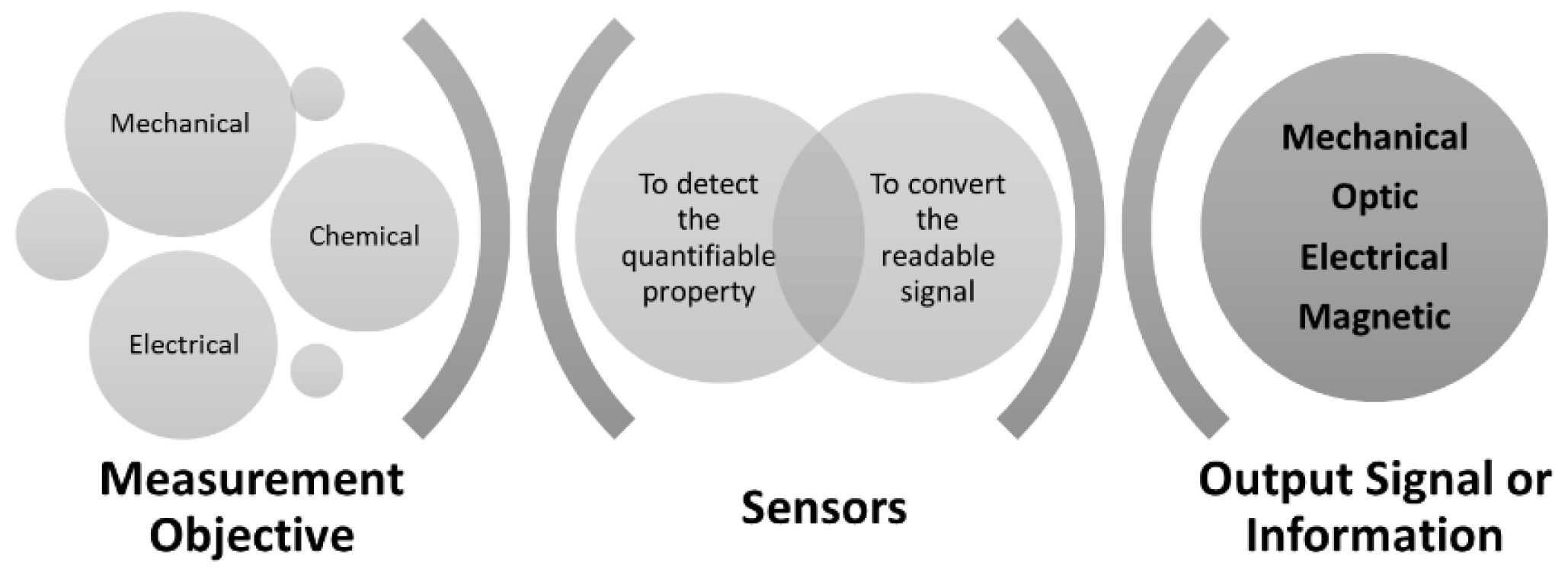

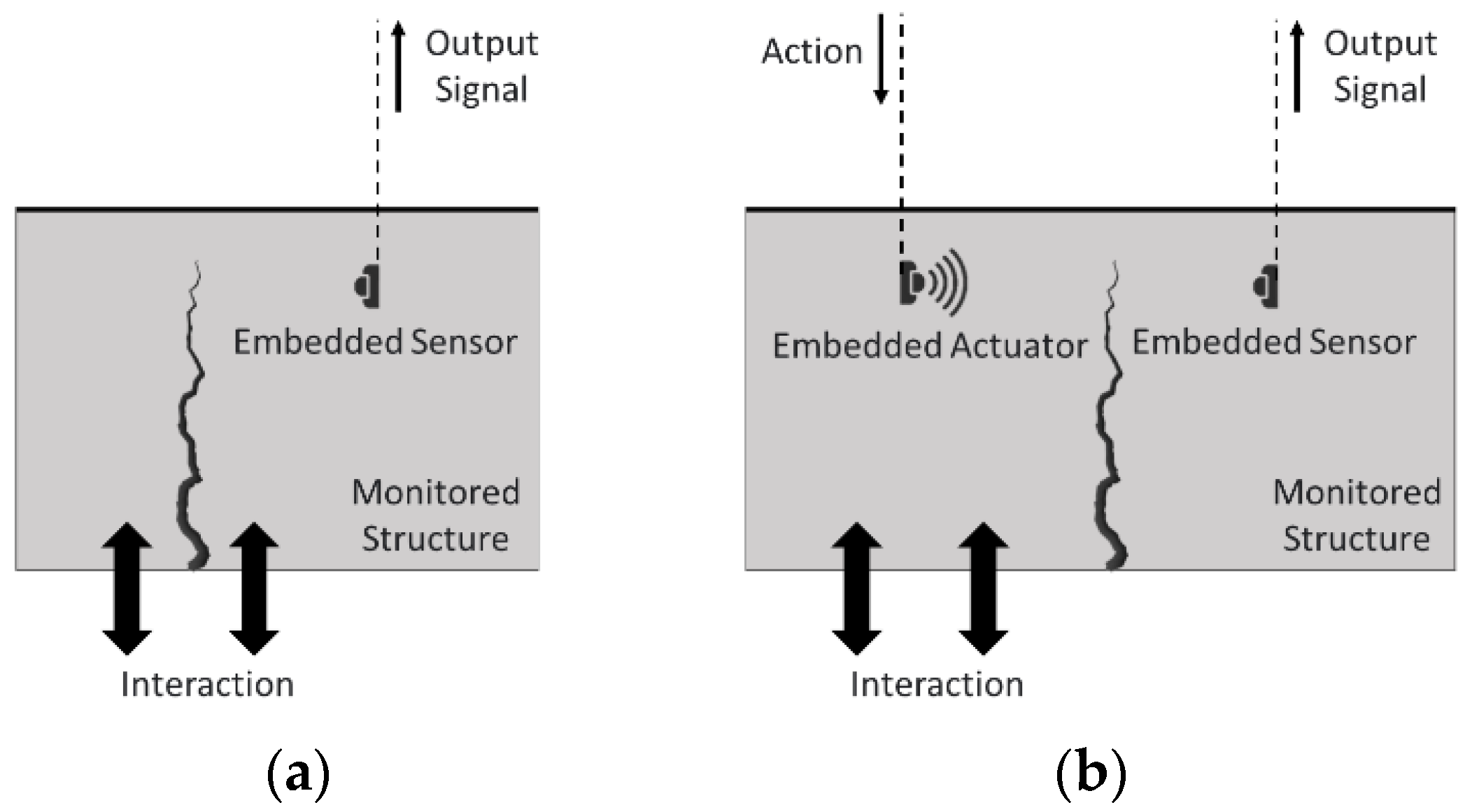

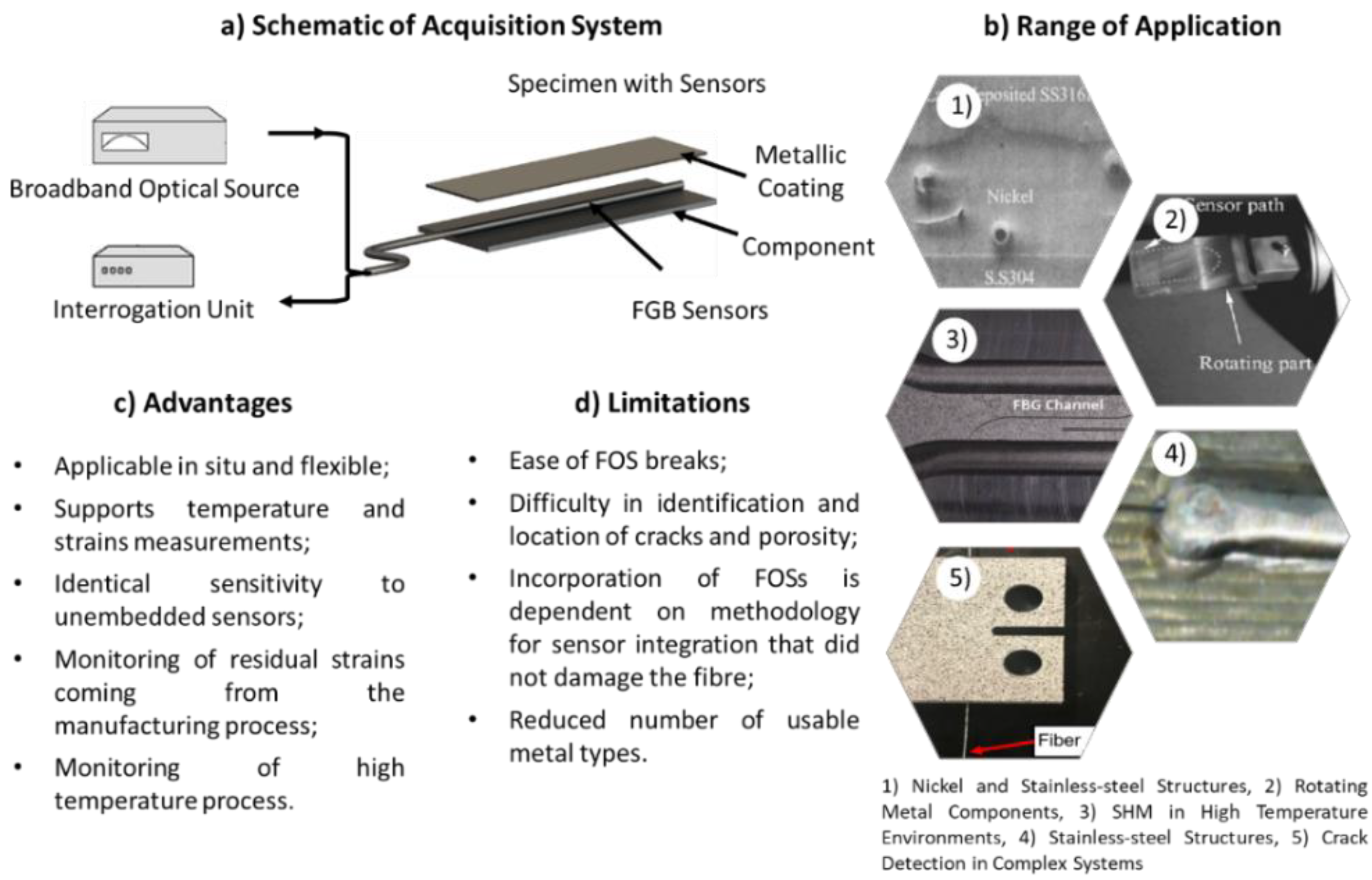
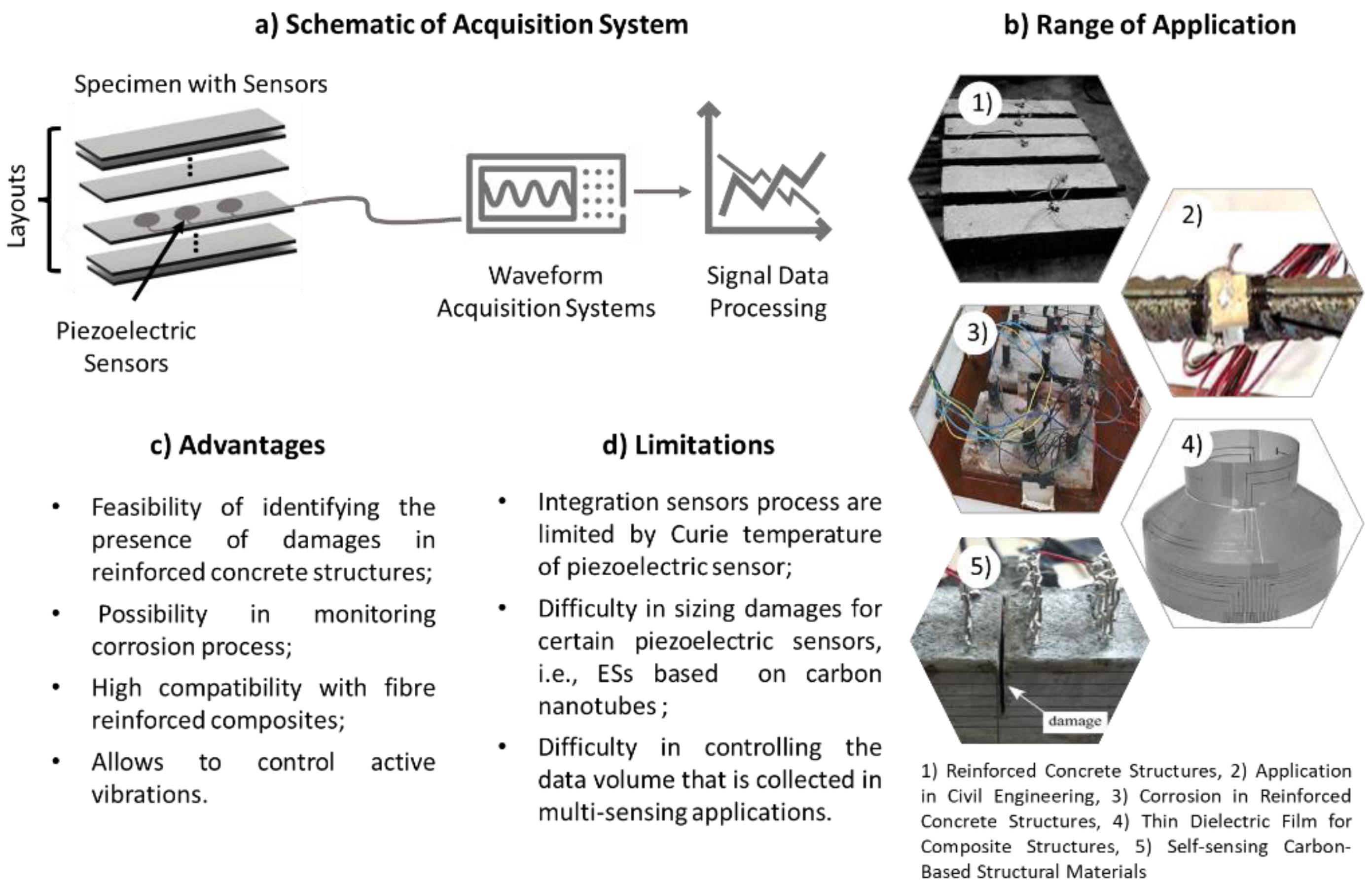
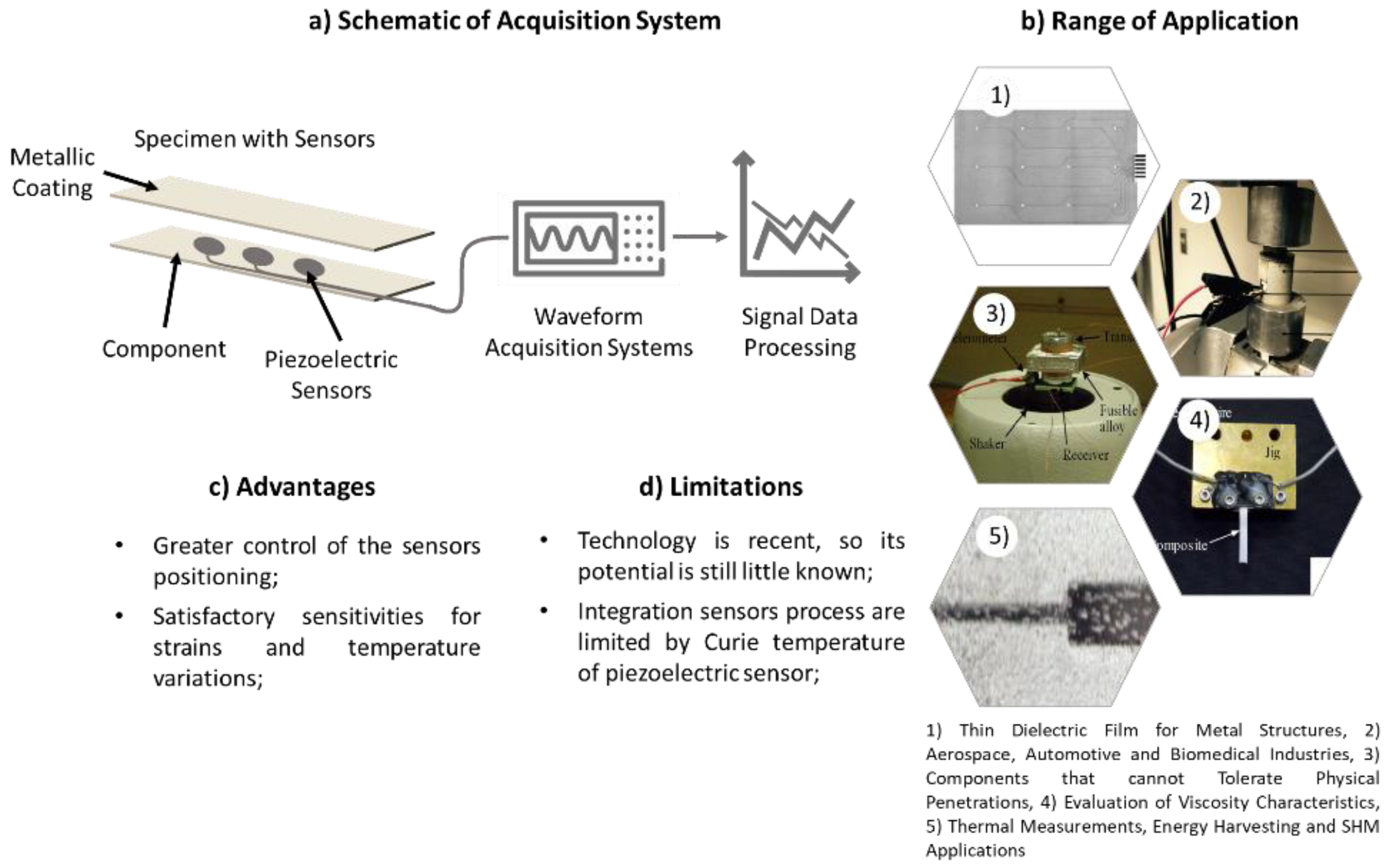
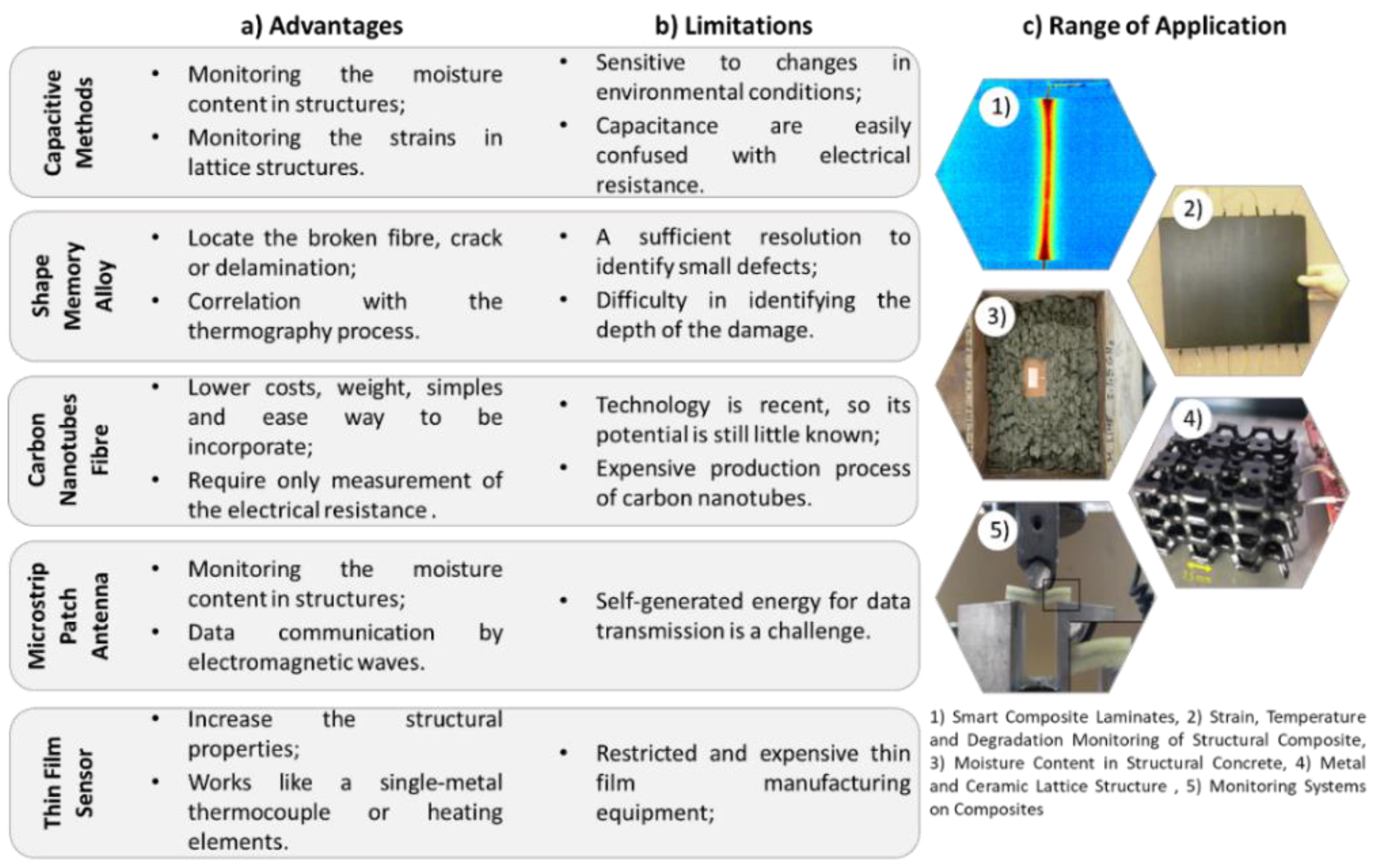


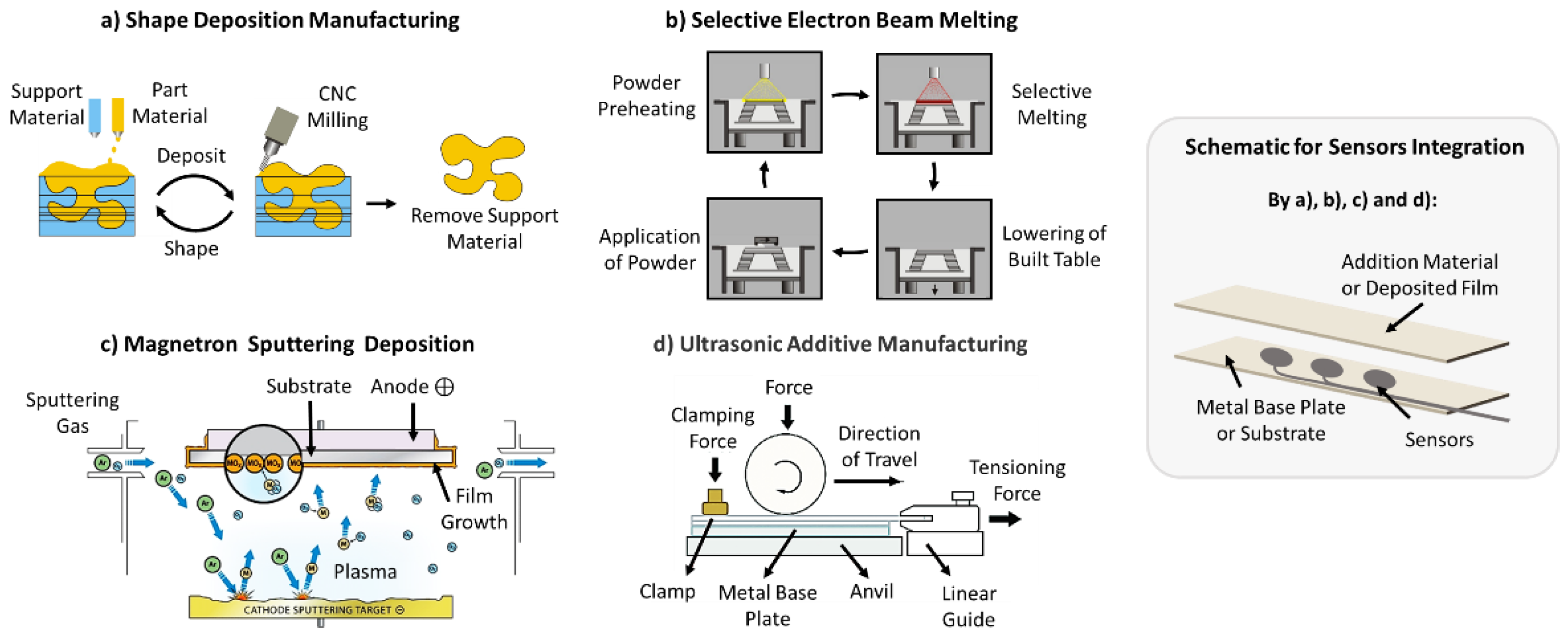
| Point Sensor | Quasi-Distributed Sensor | Distributed Sensor | |
|---|---|---|---|
| Sensors | Fabry–Perot Cavity Fibre Bragg Grating Long gage sensor | Fibre Bragg Grating | Raman/Rayleigh Brillouin |
| Measurands | Strain (displacement, pressure, temperature) | Strain (displacement, acceleration, pressure, relative fissure, inclination, etc.) | Temperature/Strain |
| Modulation Method | Phase-modulated optical fibre sensors, or interferometers | Wavelength | Intensity |
| Schematic | 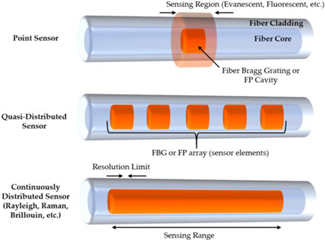 | ||
| Author | Methodology of Integrating Sensors | Measurements | Sensitivity | Applications |
|---|---|---|---|---|
| Kuang et al. [62] (2001) | Open Contact Moulding Processes | Strain | - | Carbon Fibre/Epoxy Laminate. |
| Keulen et al. [63] (2011) | Open Contact Moulding Processes | Strain | 0.001 nm/m | Composite Panel |
| Ramly et al. [64] (2012) | Resin Infusion Processes. | Strain | - | Sandwich Composite Panel |
| Bremer et al. [65] (2017) | Open Contact Moulding Processes | Strain and Crack | 0.0033 mm/N | |
| Oromiehie et al. [66] (2018) | Automated Fibre Placement | Defects | - | Composite Components for the Aerospace Industry |
| Kousiatza et al. [67] (2019) | Fused Filament Fabrication. | Residual Strain | - | Complex Lightweight Structures |
| Mieloszyk et al. [68] (2021) | Open Contact Moulding Processes | Temperature and Strain | - | Marine Applications |
| Hurtado et al. [69] (2021) | Resin Transfer Moulding | Strain | up to 7500 | Fibre-Reinforced Polymer Structure Failure |
| Author | Methodology of Integrating Sensors | Measurements | Sensitivity | Applications |
|---|---|---|---|---|
| Leng et al [71] (2003) | Open Contact Moulding Processes | Strain | - | Carbon Fibre-reinforced Polymer |
| Oliveira et al. [70] (2008) | Compression Moulding Processes | Strain | 2.6 /N | Carbon Fibre-reinforced Polymer |
| Author | Methodology of Integrating Sensors | Measurements | Sensitivity | Applications |
|---|---|---|---|---|
| Li et al. [73] (2000) | Magnetron Sputtering and Electroplating | Temperature | 0.0245 nm/°C | Nickel and Stainless-Steel Structures. |
| Li et al. [74] (2001) | Magnetron Sputtering and Electroplating | Temperature | 0.021 nm/°C | Nickel and Stainless-Steel Structures |
| Li et al. [75] (2003) | Magnetron Sputtering and Electroplating | Strain Temperature | nm/ 0.0334 nm/°C | Monitoring the Accumulation of Residual Strain |
| Li et al. [76] (2004) | Layered Manufacturing | Temperature | - | Turbine Blades and others’ Rotary Metal Tooling |
| Alemohammad et al. [77] (2011) | Magnetron Sputtering and Electroplating | Residual Stress Temperature | 21 pm/°C. | Metal Cutting Tools |
| Schomer et al. [78] (2017) | Ultrasonic Additive Manufacturing | Temperature | - | High-Temperature Environments |
| Grandal et al. [79] (2018) | Laser Cladding Technology | Strain Temperature | 29 pm/°C–23 pm/°C. 0.9 pm/–1 pm/ | High-Temperature Environments |
| Jinachandran et al. [80] (2018) | Metal Packaging using Stainless Steel and Tin | Strain Temperature | 0.4456 /N 11.16 pm/°C | Iron Pipelines and other Ferromagnetic Components |
| Chilelli et al. [81] (2019) | Ultrasonic Additive Manufacturing | Cracks | Length of 0.286 0.033 mm | Complex Systems |
| Hehr et al. [82] (2020) | Ultrasonic Additive Manufacturing | Residual Stress Temperature Delamination | - | Fibre-Routing Designs and Alloy Systems |
| Author | Methodology of Integrating Sensors | Measurements | Sensitivity | Applications |
|---|---|---|---|---|
| Wu et al. [88] (2006) | Mounted on Reinforced Concrete | Damage | to V | Reinforced Concrete Structures |
| Konka et al. [89] (2011) | Open-Contact Moulding Processes | Stress Ultimate Strength | - | Composite Structures |
| Tang et al. [94] (2011) | Vacuum-Assisted Resin Transfer Moulding | Failure | - | Damage Prediction in Composites |
| Talakokula et al. [95] (2015) | Mounted on Reinforced Concrete | Corrosion | - | Reinforced Concrete Structures |
| Karayannis et al. [96] (2016) | Mounted on Reinforced Concrete | Admittance Signatures | - | Concrete Beams’ Cracking |
| Gopalakrishnan et al. [97] (2019) | Mounted on Reinforced Concrete | Conductance Signatures | - | Reinforced Concrete Structures |
| Ahmadi et al. [98] (2021) | Mounted on Reinforced Concrete | Corrosion (Electro-Mechanical Impedance) | - | Reinforced Concrete Structures |
| Sha et al. [99] (2021) | Encapsulation with Concrete, Epoxy Resin, and Curing Agent | Stress (Electromechanical Impedance) | - | Reinforced Concrete Structures |
| Huijer et al. [100] (2021) | Open-Contact Moulding Processes | Degradation Failure (Acoustic Emissions) | - | Carbon Fibre-Reinforced Plastics |
| Gayakwad et al. [101] (2022) | Mounted on Concrete | Damage (Electromechanical Impedance) | - | Concrete Structures |
| Wu et al. [90] (2022) | Mounted on Reinforced Concrete | Strain | 169 to 278 pC/ | Concrete Structures |
| Author | Types of Sensors | Methodology of Integrating Sensors | Measurements | Applications |
|---|---|---|---|---|
| Lin et al. [91] (2001) | Thin Dielectric Film | Open-Contact Moulding Process or Others | Damage Material Degradation | Metallic and Composite Structures |
| Takagi et al. [92] (2006) | Piezoelectric Fibres | Open-Contact Moulding Process | Active Vibration | Carbon Fibre-Reinforced Polymer Composites |
| Downey et al. [93] (2017) | Carbon Nanotubes | Mounted on Concrete | Damage Failure | SHM in Civil, Mechanical, and Aerospace Structures |
| Author | Methodology of Integrating Sensors | Measurements | Sensitivity | Applications |
|---|---|---|---|---|
| Lin et al. [91] (2001) | Open Contact-Moulding Process or Others | Damage Material Degradation | - | Metallic and Composite Structures |
| Hossain et al. [102] (2016) | Electron Beam Melting | Stress | 0.42 to 0.53 V/kN | Pressure Tubes and Turbine Blades |
| Tseng et al. [103] (2018) | Casting | Temperature | 0.37 /bit | Solid Metal Structural Component |
| Altammar et al. [104] (2018) | Sandwich Panel Manufacturing | Wave Propagation Analysis (Damage) | - | Laminate Structures |
| Yanaseko et al. [105] (2019) | Hot-Pressing Process | Displacement | 14.0 mV/ | Evaluation of Viscosity Characteristics |
| Ramanathan et al. [106] (2021) | Ultrasonic Additive Manufacturing | Strain | 9.4 mV/ | Functionalised Metal Structures |
| Author | Types of Sensors | Methodology of Integrating Sensors | Measurements | Applications |
|---|---|---|---|---|
| Ong et al. [107] (2008) | Passive and Wireless Inductor–Capacitor Resonant Circuit | Mounted on Reinforced Concrete | Water Content | Real-Time Monitoring of Water Content in Structures |
| Pinto et al. [108] (2012) | Shape Memory NiTi Alloy | Open Contact Moulding Process | Strain Distribution Damage | Carbon-Reinforced plastic Composites |
| Sebastian et al. [109] (2014) | Glass Fibre Coated with Carbon Nanotube | Open Contact Moulding Process | Strain | Carbon-Reinforced plastic Composites |
| Teng et al. [110] (2019) | Microstrip Patch Antenna | Mounted on Reinforced Concrete | Moisture Content Deterioration | Reinforced Concrete Structures |
| Santiago et al. [111] (2020) | Capacitance System | Additive Manufacturing. | Deformation Impacts | Metal and Ceramic Lattices |
| Cougnom et al. [112] (2021) | Thin Films | Magnetron-Sputtering Deposition and Open Contact-Moulding Process | Heating Elements | Fabrication of Heating Elements. |
| Meoni et al. [113] (2021) | Carbon Nanotubes | Mounted on Reinforced Concrete | Strain | Reinforced Concrete Structures |
| Gino et al. [114] (2022) | PZT Powder | Resin Infusion Processes | Loads (Through the Electrical Signal) | Glass Fibre-reinforced Polymer |
| Author | Types of Sensors | Methodology of Integrating Sensors | Measurements | Applications |
|---|---|---|---|---|
| Li et al. [73] (2000) | Thin-Film Thermo-Mechanical Sensor | Laser Assisted Metal Deposition | Strain | Nickel and Stainless-Steel Structures |
| Cheng et al. [120] (2007) | Thin-Film Thermocouple | Ultrasonic Metal Welding | Temperature | Nickel, Stainless-Steel, and Titanium Alloy Tools |
| Zhang et al. [121] (2008) | Micro Ring Sensor | Laser-Assisted Metal Deposition | Temperature | Monitoring of Manufacturing Processes |
| Hahnlen et al. [122] (2010) | Shape Memory NiTi Alloy | Ultrasonic Additive Manufacturing | Temperature | Monitoring of Manufacturing Processes |
| Juhasz et al. [123] (2020) | Passive Sensor-Printed | Hybrid Manufactured Metal Structure | Strain | Metal Structural Components. |
| Sholl et al. [124] (2021) | Eddy Current Sensors | Laser Powder Bed Fusion. | Crack Propagation | Metal Structural Components. |
Publisher’s Note: MDPI stays neutral with regard to jurisdictional claims in published maps and institutional affiliations. |
© 2022 by the authors. Licensee MDPI, Basel, Switzerland. This article is an open access article distributed under the terms and conditions of the Creative Commons Attribution (CC BY) license (https://creativecommons.org/licenses/by/4.0/).
Share and Cite
Ferreira, P.M.; Machado, M.A.; Carvalho, M.S.; Vidal, C. Embedded Sensors for Structural Health Monitoring: Methodologies and Applications Review. Sensors 2022, 22, 8320. https://doi.org/10.3390/s22218320
Ferreira PM, Machado MA, Carvalho MS, Vidal C. Embedded Sensors for Structural Health Monitoring: Methodologies and Applications Review. Sensors. 2022; 22(21):8320. https://doi.org/10.3390/s22218320
Chicago/Turabian StyleFerreira, Pedro M., Miguel A. Machado, Marta S. Carvalho, and Catarina Vidal. 2022. "Embedded Sensors for Structural Health Monitoring: Methodologies and Applications Review" Sensors 22, no. 21: 8320. https://doi.org/10.3390/s22218320
APA StyleFerreira, P. M., Machado, M. A., Carvalho, M. S., & Vidal, C. (2022). Embedded Sensors for Structural Health Monitoring: Methodologies and Applications Review. Sensors, 22(21), 8320. https://doi.org/10.3390/s22218320









